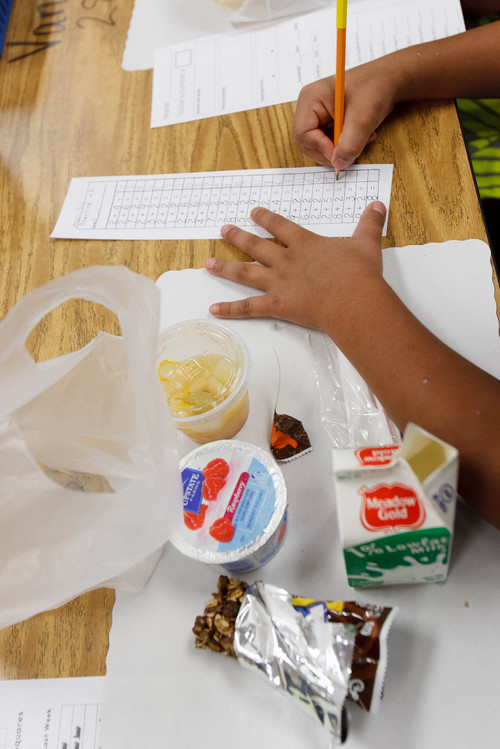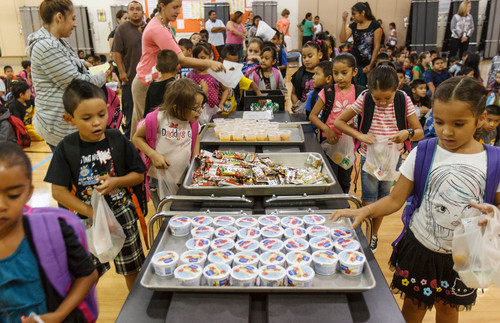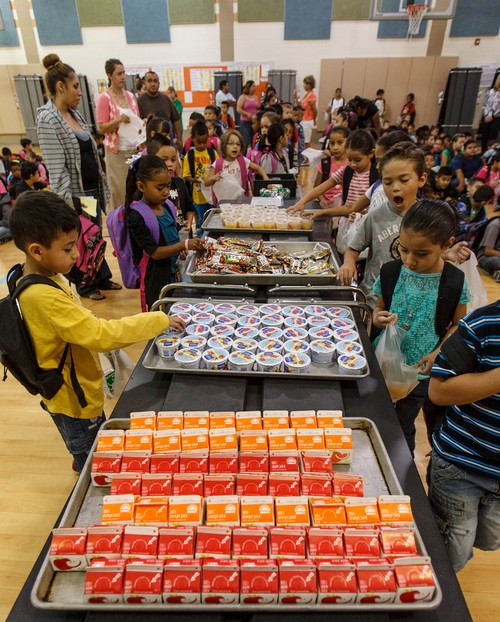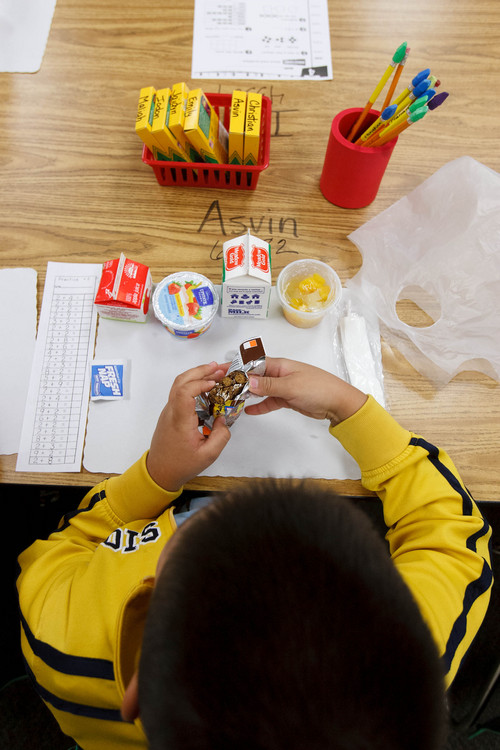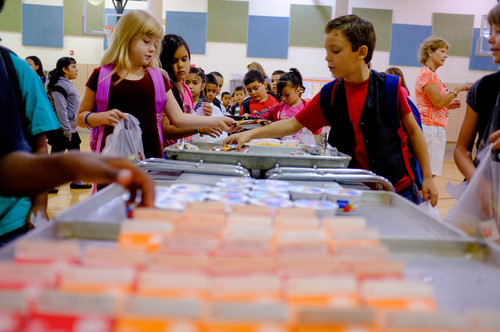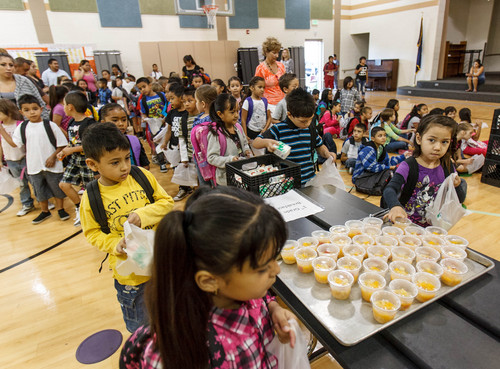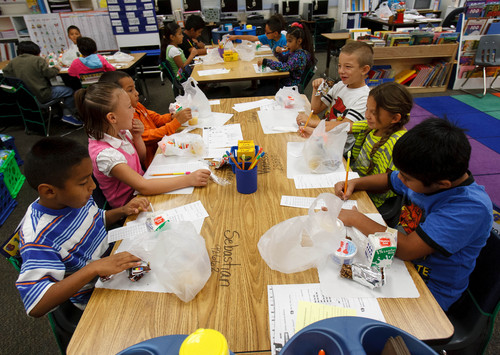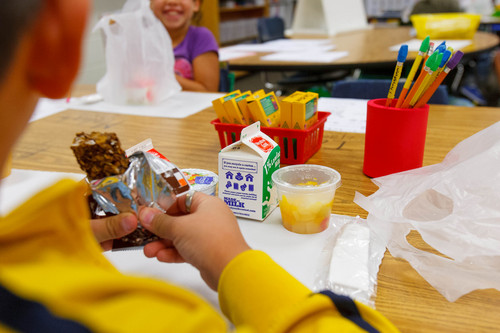This is an archived article that was published on sltrib.com in 2013, and information in the article may be outdated. It is provided only for personal research purposes and may not be reprinted.
In grade school, a sugary kick started Daniel Meza's day.
"I just remember doughnuts for breakfast" in the school cafeteria, he said. Come junior high, they gave way to French toast and hash browns. Now, Utah students across the state can choose apples, milk and whole grain waffles to take on the run.
"It's good that they're giving us healthier stuff," said Meza, 15, a West High sophomore. The evolution shows Utah has gained ground in a nationwide battle to improve school fare and cater to students on the go.
But an incoming set of federal rules poses a new challenge: Next school year, rules will limit vending machines — and club fundraisers or other events on school property — to popcorn, trail mix, natural fruit juice and other more-healthful options.
A healthy overhaul of school meals has already pushed down the number of students served last year. Right now, vending machines are the main competition for lunch and breakfast programs.
"It's quicker to just go to a vending machine and grab a Gatorade and a bag of chips and call it lunch" than to wait in line, said Jodi Vlam, nutrition director at Alpine School District. "Or to leave campus, or not eat at all."
Purging the former junk-food havens will drive even more students from campus in pursuit of sugar, fat and salt, predicts Granite School District nutrition director Rich Prall. It will deal another blow to the lunch program and a new one to school vending earnings.
—
Fun packaging and Facebook • Even before the menu changes, schools faced unfavorable odds against jammed student schedules, neighboring fast-food joints and burgeoning enrollment. For some students, school lunch just isn't cool. Others simply want to quit campus for a little while.
So some schools are getting creative, trying restaurant-style meals, social media updates and a breakfast period after the first bell but before announcements.
At Alpine high schools and junior highs, entrees mirror healthier fast-food options: main dish salads, with choices such as Mandarin or Southwest chicken. Cafeteria workers bread chicken breasts and bake them instead of frying.
More students are choosing salads since the new versions appeared last year, Vlam said, especially male athletes.
The district also replaced old plates with black bowls and clear lids, mimicking restaurant to-go containers. The number of students buying those lunches went up sixfold, Vlam said.
District officials may soon task photography and marketing classes with luring students to the lunchroom. In Provo District schools, such strategies include equipping each kitchen with a digital camera. Workers post photos of taco salads and fresh watermelon to Facebook for families and students.
Another option: stocking vending machines with ready-to-go lunches, such as turkey sandwiches with crackers and fruit.
But it might not be enough. At Alpine's Lone Peak High, McDonald's beckons students from across the street, guiding them in with a light-up pedestrian walkway.
—
Fast break • Some students in Ogden schools hop off the bus, walk through the commons and on to class — whether they've had breakfast or not. By second period, they hit the vending machines for chips and soda, district dietitian Kristine Scott said.
Three out of four district students qualify for free or reduced-price school meals, but many forgo them, Scott said.
"This generation's kind of like that: 'What can I get right now? What can you do for me? I don't care about breakfast, but if it's right here, I'll eat it.' "
So officials this year are setting up breakfast carts along the route from bus to classroom for students at Washington High.
Some elementary students can pick up grab-and-go bags on the way to class, and they have 15 minutes to munch on them after the first bell.
California's Orange County public schools and others in St. Paul, Minn., have adopted such tactics, so Ogden is trying them, Scott said. Other efforts include separating cafeteria lines, based on what students are choosing, to streamline the wait.
—
Losing sugar — and money • For some school lunch programs, competition comes from the students. Granite School District students line up for doughnuts and Coke to help fund the football team and other organizations.
Cash is otherwise hard to come by for those groups, Prall said, and students are a reliable clientele. "Kids are going to want that stuff."
But the less-junky stuff can hit the spot, too, nutritionists contend. A handful of almonds and an apple make for a quick, crunchy and cheap snack, said Eve Steiner, a Salt Lake City dietitian.
A super-sweet Snickers or another candy bar "doesn't taste like food. It's gross," she tells clients. "You have to instill in your children how food is supposed to taste."
Meza, the West High sophomore, makes a twice-weekly trip to the vending machine for a bag of Ruffles. But he's willing to give the popcorn a shot, he said earlier this summer.
His sister, Jessica Meza, 13, said she likes granola bars and would like to see them in lunch lines and vending machines.
"They should offer both" healthier options and indulgent ones like Funyuns, she said. " 'Cause it's your choice."
What's changing?
Federal rules have typically stopped short of dictating what's in school vending machines. That is set to change for the 2014-2015 school year, when schools must substitute more-healthful items. Some Utah schools say they've already started to gear up for the new regulations.
Munchies mandate • Schools must sub out junk food in vending machines for fruits, nuts and whole grains. This applies to snack carts and any other kiosks on school grounds. School officials expect to have a tough time finding such items during the next few months, but they believe snack makers will offer options within a year or two.
A fine frenzy • Right now, schools must limit candy and soda sales to non-lunch periods, in non-dining areas. But some students munch and wander, so it's tricky to regulate. Last year, Davis High in Kaysville and Box Elder High in Brigham City faced $15,000-$20,000 fines for violating the rule.


